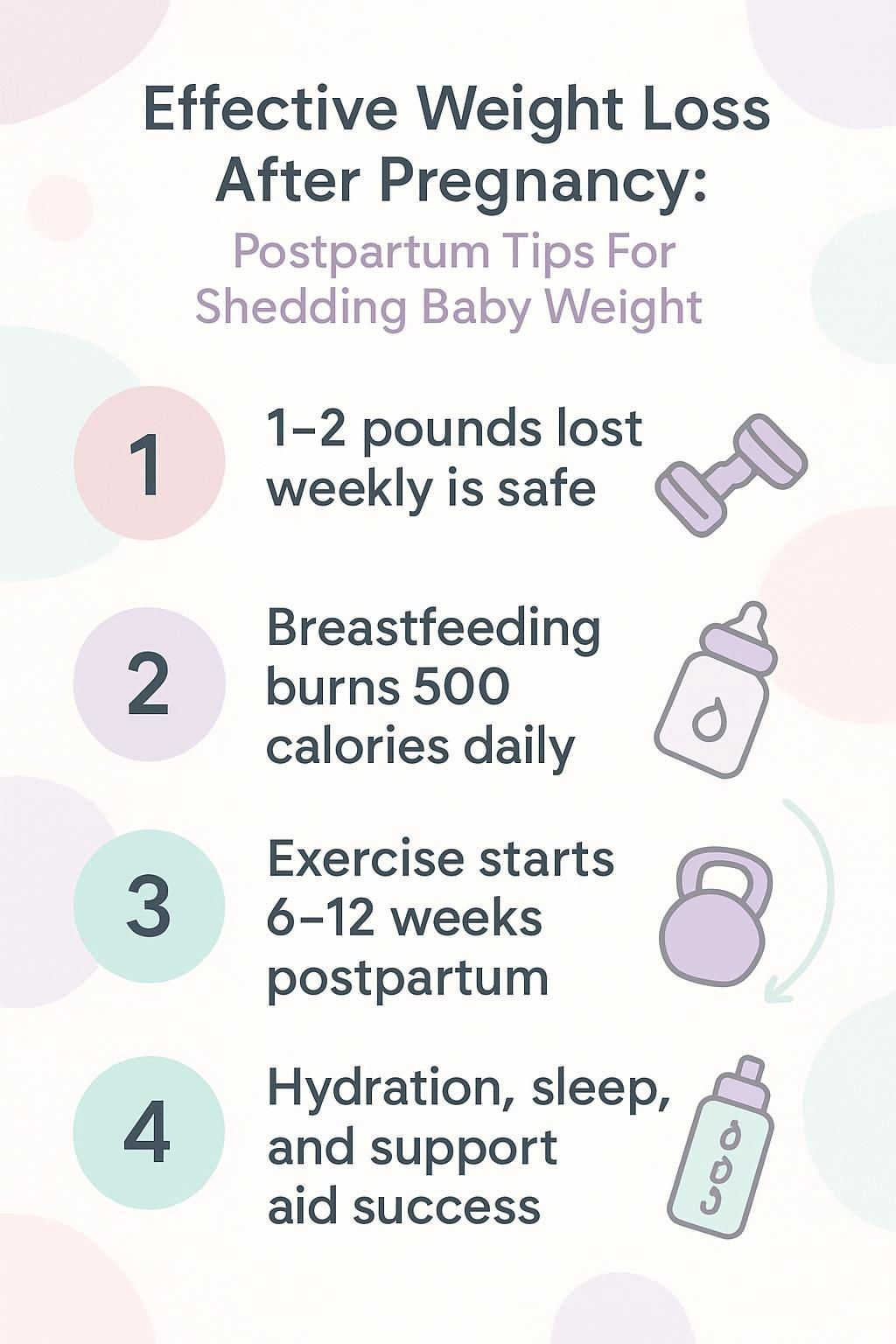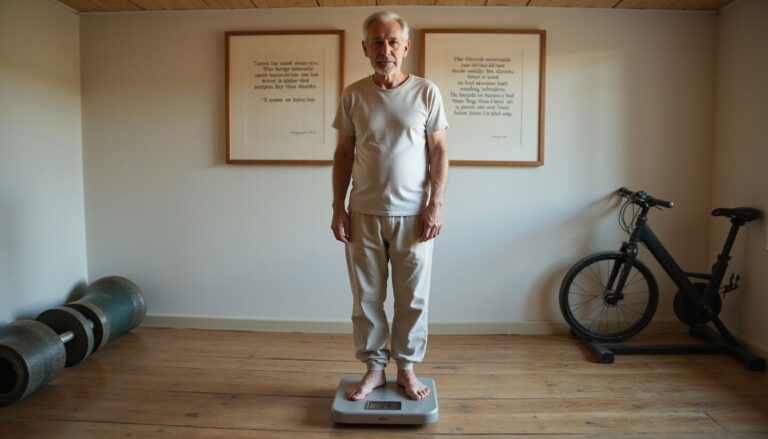Effective Weight Loss After Pregnancy: Postpartum Tips For Shedding Baby Weight
Our Nutrition Assistant AI Suite will transform your body. You will lose fat, get toned, and build muscle. Gain confidence and optimal health.
Losing weight after pregnancy feels hard for many new moms. Research shows almost half of women gain more than doctors recommend during pregnancy. If weight loss after pregnancy seems confusing, this guide gives you clear steps that protect your health.
You will learn what to eat, how to move, and which habits support steady progress. The goal is safe postpartum weight loss, not quick fixes. Start with one small change today and build momentum.
Key Takeaways
- Nearly half of women gain more pregnancy weight than recommended, and about 75 percent remain above pre-pregnancy weight at one year, based on CDC data.
- Safe progress means losing about 1–2 pounds per week. Avoid crash diets and focus on nutrient-dense meals with lean protein and fiber.
- Breastfeeding can burn roughly 500 extra calories per day. WHO, AAP, and CDC recommend exclusive breastfeeding for the first 6 months when possible.
- Start only light exercise after medical clearance, often around six weeks after vaginal birth and twelve weeks after a C-section.
- Good sleep, hydration, and support from health professionals, family, or groups improve the chances of lasting weight loss.

What does “baby weight” mean?

Baby weight is the total weight you gain during pregnancy. It includes the baby, the placenta, amniotic fluid, breast tissue, extra blood, and a larger uterus. The CDC also notes that your body stores fat as an energy reserve for birth and breastfeeding.
These reserves support milk production and healing. Right after delivery, most women lose about 10 to 13 pounds from the baby, placenta, and fluid. How much you gained and your starting body mass index, or BMI, guide what a healthy loss looks like. Your clinician uses these ranges to help you set goals.
Much of the ‘baby weight’ is necessary for fueling both postpartum healing and successful breastfeeding.
Factors that influence postpartum weight loss
Several forces shape your journey. Pre-pregnancy weight, delivery type, feeding method, sleep, and hormones all affect pace and results.
How does pre-pregnancy weight and BMI affect weight loss?
Starting BMI matters. For one baby, the CDC advises a gain of 25–35 pounds for people who begin pregnancy at a healthy BMI. Targets differ if you begin underweight, overweight, or with obesity.
Higher starting BMI can make weight loss after delivery slower. A 2019 LifeCycle Project analysis linked maternal obesity to greater risks like high blood pressure, type 2 diabetes, heart disease, and some cancers. That is a strong reason to work with your provider on a safe plan.
A friend of mine started pregnancy with a higher BMI. Her progress took longer, but steady meals and daily walks, with support from friends, helped her reach her goal over several months. Tracking food and focusing on nutrient-dense choices can make a real difference.
How does delivery type impact postpartum weight?
After a vaginal birth, many people can start short walks or gentle pelvic floor work within days, if cleared by a clinician. Early movement boosts energy and supports gradual weight loss.
A C-section is abdominal surgery, so healing takes more time. Most doctors suggest waiting at least six weeks before structured workouts. Slower progress is normal while your incision and core recover. Aim for patience and protect healing tissues.
One mom shared,.
I waited until my six-week checkup post-C-section before starting short walks with my newborn in the stroller.
Whatever your delivery, experts suggest keeping loss to about 1–2 pounds per week. That pace supports your health and breastfeeding.
Can breastfeeding help burn calories?
Yes. Breastfeeding uses energy, often about 500 extra calories per day. WHO, AAP, and the CDC encourage exclusive breastfeeding for the first 6 months for infant health and maternal benefits.
Early on, you may not see large changes in weight. Milk supply requires energy, especially in the first three months. Many parents notice steadier loss later if they keep a healthy postpartum diet.
In my case, feeding frequently and choosing balanced meals helped me return to my pre-pregnancy size without strict calorie restriction or intense workouts. Research shows benefits for long-term health for both mother and baby.
How do sleep and hormones affect weight loss?
Short sleep makes weight control harder. Adults who sleep less than six hours per night often store more body fat. For new parents, night feedings are real, but every extra hour of rest helps.
Hormones shift after birth. Leptin and ghrelin, which affect hunger and fullness, can fluctuate with sleep loss. That can drive cravings and slow weight loss, even if you are eating well and moving daily. Ask for help with baby care where possible to improve rest. Small changes, like a caffeine cutoff in the afternoon, support better sleep and steadier progress.
Tips for effective postpartum weight loss
Consistency beats intensity. Combine small food changes with gentle movement and build from there.
Why is patience and setting realistic goals important?
Weight often drops faster in the first 6 months, then slows. About 75 percent of women remain above pre-pregnancy weight at one year, and around 25 percent keep more than 20 pounds.
Set goals you can meet, like losing 1–2 pounds per week. Healing and hormone shifts take time. Aiming for slow, steady change protects your mood and your body. Pair whole grains and protein-rich foods with daily walks or pelvic floor work, such as Kegels, for a balanced start.
Why should crash dieting be avoided?
Very-low-calorie plans cut essential nutrients during a time your body needs them most. Energy plummets, which makes caregiving and milk production harder. Breastfeeding parents often need extra calories to support supply and recovery.
I once slashed calories in the first days after birth and felt weak and dizzy. My doctor explained that fast cuts can harm healing and milk. Choose a healthy diet that protects muscle and supports your heart and pelvic floor.
How does breastfeeding support weight loss?
Producing breast milk uses stored fat and dietary calories. Many parents see gradual loss over months, especially after the early period of high energy needs.
Health groups like WHO, AAP, and CDC recommend exclusive breastfeeding for 6 months. Longer duration often links to more weight loss for the parent and a lower risk of cardiovascular disease later. Results vary, so keep the focus on nutrition, hydration, and rest.
How can you monitor calorie intake effectively?
Tracking helps you spot patterns. Use a food diary, quick phone photos, or an app to log meals and snacks. Seeing your intake in writing highlights hidden sugar and helps you choose better snacks.
If breastfeeding, many parents can trim about 500 calories per day and still protect supply. Pair tracking with simple swaps. Keep water nearby, choose fruit over soft drinks, and plan protein-rich snacks. Share your log with a friend or group for accountability.
Nutritional guidelines for postpartum weight loss
A balanced postpartum diet supports steady loss and recovery. Think color, fiber, and protein at each meal.
What are nutrient-rich foods to focus on?
Build your plate around whole foods. Choose colorful fruits and vegetables, lean meats, fish lower in mercury, beans, nuts, seeds, yogurt, and other dairy. These foods deliver vitamins, minerals, and quality protein that your body uses for healing.
Whole grains like oats and brown rice add fiber for fullness and steady energy. Fresh food supports your immune system and your mood. I found that swapping chips for an apple or carrot sticks cut cravings in the afternoon.
Why include high-fiber foods in your diet?
Fiber helps you feel full, which makes it easier to eat fewer calories without feeling deprived. A 2019 study found that adding just 4 grams of fiber daily led to about 3.25 pounds of weight loss over six months.
Soluble fiber slows digestion and may reduce hunger hormones. Fruits, vegetables, beans, and whole grains make it simple to reach your goal. Fiber also helps control appetite during breastfeeding and busy days with a newborn.
How to prioritize lean proteins postpartum?
Include 20–30 grams of lean protein at each meal. Good choices are chicken breast, turkey, fish, eggs, beans, nuts, seeds, and low-fat dairy. Protein has a higher thermic effect than carbs or fat, which means your body burns more calories digesting it.
Protein also raises fullness signals and lowers hunger signals. After my C-section, I added Greek yogurt and grilled chicken to lunch. That kept me satisfied and reduced grazing on sweets. Add protein to snacks too, like a cheese stick or a small handful of nuts.
Why limit added sugars and refined carbs?
Foods high in added sugar and refined flour pack calories with little nutrition. Sodas, sweet teas, pastries, white bread, and many packaged snacks spike blood sugar, then leave you hungry again.
High intake of added sugar links to obesity, type 2 diabetes, heart disease, and some cancers. The American Heart Association suggests no more than 24 grams of added sugar per day for most women. Choose whole grains over refined bread, and keep sweets as small, planned treats.
Why is staying hydrated important after pregnancy?
Water supports recovery and weight control. Think of hydration as a simple tool you can use every day.
What are the benefits of drinking enough water?
Water helps your metabolism work well. Drinking water before meals can reduce calorie intake by increasing fullness. Many breastfeeding parents also notice that good hydration supports milk supply.
Most experts suggest about 8 to 10 cups daily, more if you breastfeed. Better hydration can reduce fatigue and improve mood, which makes walks, stairs, and childcare feel easier. It also supports digestion and lowers the risk of urinary tract infections.
Why avoid sugary drinks and alcohol?
Sugary drinks add many calories without filling you up. A single can of soda often tops 150 calories. Those calories stack up fast, and they raise blood sugar, which can slow progress.
Alcohol adds 7 calories per gram, without nutrients. The CDC advises avoiding alcohol if you are breastfeeding since alcohol can pass into breast milk. I switched to unsweetened sparkling water with lime and noticed fewer cravings between meals.
Exercise recommendations for postpartum weight loss
Movement supports weight loss, mood, and strength. Start light, then build as you heal.
How to start with light exercises like walking?
Begin with short walks, gentle stretching, or easy yoga once your provider clears you, often around six weeks after birth. Low-impact movement is kind to joints yet still burns calories.
Short on time? Try three 10-minute sessions spread through the day. Gradually increase time or pace by about 10 percent weekly. I often walked with my baby in a stroller after lunch. It lifted my energy without leaving me worn out.
When and how to add strength training?
After medical clearance, ease in with 10 to 15 minutes of light resistance. Start with bodyweight squats, rows, and light dumbbells. Focus on form and comfort, especially if your abdominal muscles separated during pregnancy, a condition called diastasis recti.
Increase volume slowly. Two short strength sessions per week can rebuild muscle and support bone health. I found that adding brief strength work improved my energy more than cardio alone.
Why focus on core and pelvic floor exercises?
Your core and pelvic floor stabilize your body and protect your back. Gentle moves like deep breathing, bird dog, pelvic tilts, leg extensions, bridges, and Kegel exercises help restore strength.
For Kegels, squeeze your pelvic floor for three seconds, relax for three seconds, and repeat 10 to 15 times. Aim for three sets per day. These exercises support bladder control, posture, and safe return to activity. If you see no change after several months, ask your provider for a referral to pelvic floor physical therapy.
Why avoid high-intensity workouts initially?
Jumping into hard training too soon raises injury risk and can delay healing. Many providers recommend waiting at least 6 weeks after a vaginal birth or 12 weeks after a C-section before intense exercise or heavy lifting.
Activities like running, bicycle crunches, and heavy core work can stress healing tissues. Start low and build up. That path protects your recovery and keeps your mood and energy steadier.
How does stress and sleep affect postpartum weight?
Stress and short sleep can nudge you to eat more and move less. Managing both supports weight loss and mental health.
What role does stress play in weight retention?
Chronic stress raises cortisol, a hormone that can increase appetite and fat storage. About 1 in 9 new mothers experiences postpartum depression, which shows how common mood challenges are after birth.
Stress may push you toward sugary snacks or skipped meals. Both can slow progress. Reach out to loved ones or health professionals for support. Small steps like brief walks, deep breathing, or journaling can ease stress and help you stay on track.
What are tips for improving sleep quality?
Ask family or friends to cover a feeding so you can get a longer stretch of sleep. Set a caffeine cutoff in the afternoon to protect your sleep cycle.
Keep a steady bedtime and nap when you can. Even short naps help. Better sleep supports healing, steadies hunger hormones, and helps you make healthier choices. I used short daytime naps to power through the hardest weeks.
Where can you find support for postpartum weight loss?
You do not have to do this alone. Support improves follow-through, especially when you feel tired.
How can postpartum weight loss groups help?
Groups offer accountability and a sense of community. A 2016 study by Lemstra and colleagues found that group programs can improve consistency compared with going solo.
Members share tips on meal tracking and simple workouts. Many parents say the encouragement helps them avoid risky methods like crash dieting. Choose a support style that fits your life, whether a group, a buddy, or a virtual check-in.
When should you consult healthcare providers?
See your clinician before major changes to diet or exercise. The routine 6-week postpartum visit is a good time to review recovery and readiness for weight loss. Seek help sooner if you had a cesarean, complications, high blood pressure, or concerning symptoms.
Contact your provider right away for signs of postpartum depression, such as persistent sadness, trouble sleeping even when the baby sleeps, or difficulty bonding. Unintended rapid weight loss can signal a medical issue. During my own recovery, talking with my provider led me to a helpful group and a safer plan.
How to rely on family and friends for encouragement?
Share your goals and small wins. Loved ones can help with meals, groceries, or childcare so you can walk or rest. Trade stroller walks with a partner or friend.
Regular check-ins keep you accountable and supported. Social support makes it easier to handle stress and stick with healthy habits. Simple acts, like cooking together once a week, can move you forward.
What are common mistakes to avoid postpartum?
Skipping steps or pushing too hard often backfires. Avoid these pitfalls to protect your recovery.
Why are unrealistic expectations harmful?
Expecting fast results leads to stress and disappointment. Every body heals at a different pace. Gradual, achievable goals work best for long-term success.
After my first child, I wanted all the baby weight gone in six weeks. That mindset hurt my mood. Shifting to monthly milestones felt better and kept me consistent.
What are the risks of overexercising too soon?
Starting intense workouts without clearance raises the risk of injury. Most people should avoid high-impact exercise for at least six weeks after vaginal delivery and twelve after a C-section.
Hard training too soon can also affect milk supply. I tried heavy workouts early once and ended up with back pain for months. Slower progression protected my healing the next time.
Why is skipping meals or under-eating a problem?
Under-eating slows metabolism and drains energy. Your body needs calories, vitamins, and minerals to heal. If breastfeeding, most people need an extra 330 to 400 calories per day to support milk production.
Regular meals steady your energy and mood. I used to skip breakfast and felt dizzy until noon. Balanced meals plus water helped me feel stronger and recover faster.
What is a realistic timeline for postpartum weight loss?
Weight loss is a marathon, not a sprint. Give your body time to heal while you build healthy habits.
How much weight is lost initially after delivery?
Right after birth, most people lose about 10 to 13 pounds from the baby, placenta, and amniotic fluid. In the first week, extra fluid shifts out, which can add a few more pounds lost. Swelling usually fades during this period.
I noticed the biggest drop in the first days, before I changed my eating or exercise. That early change is your body resetting after giving birth.
What does gradual progress over months look like?
Most people lose weight faster in the first 6 months, then progress slows. A safe target is 1–2 pounds per week after the early recovery period.
Total loss varies based on how much you gained during pregnancy. Clothing fit, measurements, and energy can show progress when the scale moves slowly. It took me about 8 months to drop 12 pounds after my second baby. Daily walks and more vegetables made the biggest difference.
Why is self-care important during postpartum weight loss?
Self-care fuels consistency. Small, daily choices build confidence and staying power.
How to celebrate small wins?
Track your habits with a food diary or an app. Mark days you meet your walking goal or choose a balanced meal. Each small choice is a step forward.
Share your wins with a friend or group. Positive feedback boosts motivation. Research shows that celebrating small successes supports long-term change, which matters more than any single weigh-in.
Why focus on overall health, not just weight?
Good health is bigger than a number. Balanced meals, regular movement, and better sleep improve energy, mood, and time with your baby. These habits also lower the risk of type 2 diabetes and heart disease.
I felt stronger when I celebrated a full night of sleep or a week of planned meals. Shifting focus from the scale to daily strength made parenting feel easier.
Conclusion
Managing postpartum weight loss takes patience, steady habits, and self-compassion. Focus on nutrient-rich meals, lean proteins, fiber, and plenty of water. Keep movement gentle at first, then add strength training when cleared by your provider.
Aim for about 1–2 pounds per week. Limit added sugars, refined carbs, and alcohol. Seek help from family, groups, or your healthcare team when you need it. This guidance supports safe weight loss after pregnancy and a healthier life for you and your baby.
Medical disclaimer: This information is educational. Talk with your healthcare provider for advice that fits your situation.
FAQs
1. How soon can I start trying to lose weight after pregnancy?
Most health professionals recommend waiting until after your six-week postpartum checkup before starting a weight loss plan. This allows your body to recover from childbirth. A study published in the Journal of Women’s Health found that gradual weight loss, about one to two pounds per week, is safe for most new mothers.
2. What are the safest ways to shed baby weight?
Safe methods include eating a balanced diet, engaging in regular physical activity like walking or swimming, and getting enough sleep. The Centers for Disease Control and Prevention reports that combining healthy eating with exercise helps women lose more weight than dieting alone. Breastfeeding may also support weight loss for some women.
3. Are there specific foods that help with postpartum weight loss?
Foods rich in fiber, lean protein, fruits, vegetables, and whole grains can help you feel full longer while providing essential nutrients. According to the Academy of Nutrition and Dietetics, these foods support steady weight loss and help maintain energy levels during recovery.
4. Can personal experience help guide postpartum weight loss?
Personal stories can offer practical advice. For example, one mother shared that setting small goals, such as taking daily walks with her child, helped her stay motivated. Research supports that setting achievable goals increases long-term success for postpartum weight loss.
Summary: Waiting for your body to heal before starting weight loss is important. Safe weight loss includes healthy food choices, exercise, and realistic goals. Evidence shows gradual changes work best for shedding baby weight after pregnancy.







